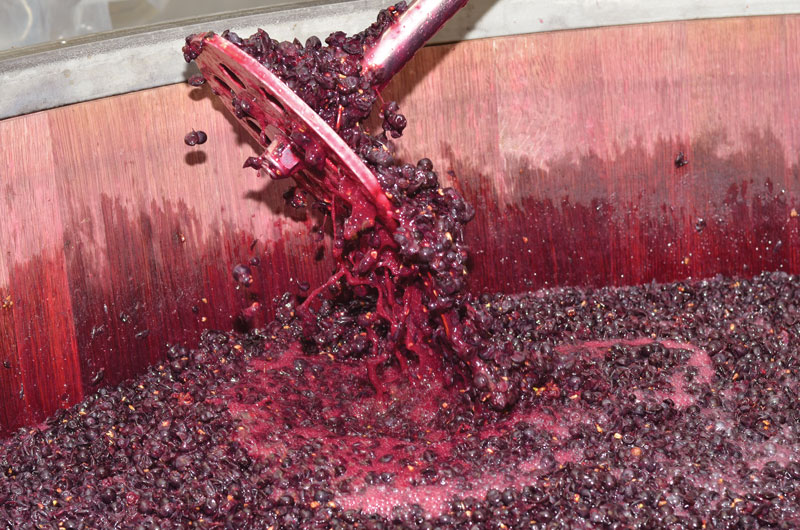Wine Wizard
Lowering pH
The pH of these grapes do seem high. For California grapes, I like to see whites in the 3.30–3.45 range and reds in the 3.45–3.65 range when picked. However, many of our
Adding body to country wine
You are really onto something here! Water is added to recipes for many different reasons. If you’re making a wine with flowers or dry fruits (like dandelion wine or elderberry wine) you’ll
Understanding Degree Days
Interestingly, even though your heat summation units are low, you are close to the Pacific Coast so I am guessing your winters are mild. European grapevines (Vitis vinifera) grow at a minimum
Is chitosan safe for those with shellfish allergies?
Though I’m no medical doctor (and certainly don’t play one on TV), from what research I was able to pull together, if I personally had a shellfish allergy I would feel comfortable
Browning in Red Wines
There’s the old saw about the sow’s ear and the silk purse. It reminds me of my old adage of “never blend a loser,” which admonishes readers against blending bad wine into
MLF Test Strips
You are right, at WineMaker magazine we typically don’t want to advertise one product over another. That being said, we are always open to new advances and products that help our readers.
Maple Wine
Maple sap is a great source of natural sugar and certainly qualifies as home winemaking material. What is less certain, as you’ve found out, is how much of those subtle maple aromas
When to Add an Airlock
Kaboom! Nobody likes an exploding carboy! “Fermentation happens,” as one of my professors at UC-Davis always used to say. Sounds like the perfect home winemaking meme to me (or t-shirt). As wine
Timing Purchases
That’s a great question and one, like so much in winemaking, that can be answered by a bit of a compromise. You’re on the right track by ordering your supplies right before
Adding Skins to a Red Ferment
There’s an ancient tradition of making wine using skins “donated” from other fermentations and projects. The one you list above is one such scenario. The most well-known incidence of this practice includes
Monitoring Malolactic
MLF is a bit confusing for some because it’s called a “fermentation” but it’s certainly not as active, visible, smellable, and in your face as your primary sugar-to-alcohol fermentation. MLF happens when
Removing Stains in Carboys
There is indeed a combination of things I think could help, but it may take a little bit of elbow grease on your part. Two years is a long time for a
Boosting Aromatics in White Wines
It sounds like you’re doing a lot of things right to optimize aromas in what should be “aromatic” white varieties. I would recommend you make sure your full process includes the following
Will Alcohol Kill Mycoderma?
There is a great summary of what mycoderma is and ways to deal with it written by Daniel Pambianchi at www.techniquesinhomewinemaking.com/white-surface-film. Folks can check out that blog post for a deep dive,
Sanitizing with Sulfur Dioxide and Citric Acid
I’m happy to help clear up the argument for you. First, I have to say, “good on you” (as my New Zealand harvest interns used to say) for questioning what you hear;
Tips For a Successful Malolactic Fermentation
I’m glad you’re using an ML nutrient (Opti’Malo Plus™ — made by Lallemand and sold through various outlets like Scott Labs and many home winemaking stores), which makes for the most predictable
Thoughts for Underripe Red Grapes
I don’t know how many cases of rosé wine are consumed in the United States each year, but I know it’s a heck of a lot. Pooh-poohed in the past as cheap
Tips For a Complete Fermentation
I’m sorry to hear about your fermentation troubles! Indeed, it’s one of the most important aspects of winemaking to master since sluggish and incomplete fermentations can ruin a batch. Here are some
Reducing acid in wine
In challenging vintages where grapes just don’t get ripe enough, or in areas where summer is cool and the growing season is short, acid reduction methods can really help. The most used
Over-Sulfiting Your Grape Must
I think you’ll be OK. Even if you’ve made a double sulfur dioxide addition to your Chambourcin grape must it should eventually still take off, albeit perhaps a bit more slowly than
Micro-Oxygenation on a Small Scale
A brewer’s O2 wand is an interesting tool and one I’m not familiar with personally, though I think I understand the concept. There isn’t much of a description of the item on
Reducing Bitterness in Citrus Wine
Ah, the glory and heartbreak that are citrus fruits in winemaking. So many aromas! So many bright flavors! So much acid! And so many potential bitter compounds. This is where a good
Troubleshooting a Blueberry Wine
Ah, blueberry wine! Blueberries, huckleberries, and black currants are all favorites when it comes to home winemaking, partly because they can make dark, mouth-filling wines that can resemble the finest red wines
Aging Wine Temperatures
I read the article you reference and I agree with the advice, to a point. That it’s OK to keep wines in the bulk-aging stage (before bottling) warmer (the referenced article says
Using Screw-Top Bottles at Home
It’s a little tough to tell from your letter which kind of screw-top bottles you’ve got so I’m not sure if you’re talking about what I would call screw top “sample bottles”
